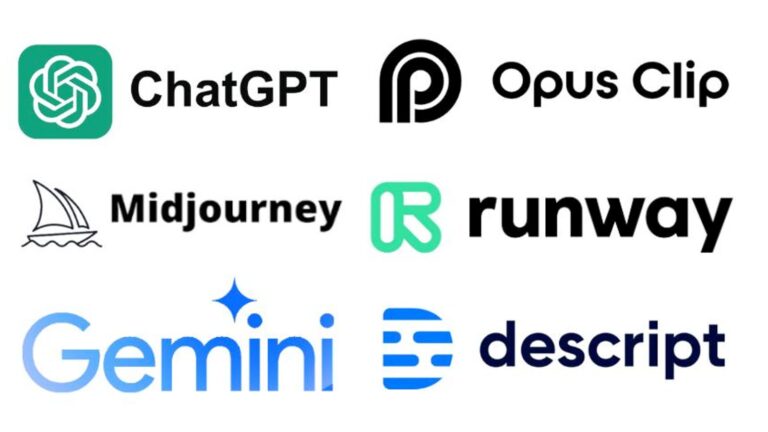Generative AI tools make content creation easier than ever. Want to post a TikTok video but don’t know how? Tools like Opus Clip let you cut your video and add captions in just a few clicks. Want to write a newsletter but don’t know what to write? OpenAI’s GPT-4 will generate 20 ideas to get you started. Quick and easy content creation. That’s what we wanted, right? Not exactly.
Indeed, one of the undeniable benefits of AI tools is that they lower the barrier of entry for beginners. Beginners can start creating without being intimidated by technical software. If you’ve ever opened Adobe Photoshop without any prior experience, you know that sinking feeling of having a creative vision but not the know-how to execute. Now, with AI tools, anyone can create and publish content. I started posting on TikTok and Instagram a few years ago, but with just a few taps I can remix my videos to share and educate millions. It’s amateur time. The $150 billion creator economy is based on this premise. We are witnessing an expansion of voices and perspectives in media, especially those that have been historically underrepresented. Welcome to the era of democratization of media production.
Another beneficiary of Gen AI tools is Hollywood. Image and video generators can reduce production costs. Introductory establishing shots that previously required drones or stock footage can now use Runway’s Gen-3 Alpha text-to-video AI models to generate high-fidelity videos of vast cities. While many of these Gen AI tools are in their early stages, some are already being incorporated into the filmmaking process. Visual effects artist Evan Halleck used Runway to quickly and cost-effectively edit scenes for the Academy Award-winning “Everything Everywhere All At Once.” Forbes columnist Charlie Fink has written an article that paints a far-off future where an AI-generated movie wins an Oscar.
Runway released a demo video of the Gen-3 Alpha on YouTube on July 2, 2024. The first 30 seconds are … [+]
As consumers of content from social media (TikTok, Instagram, YouTube, etc.) to traditional media (Hollywood, etc.), we don’t get to see how the sausage is made. But creators experience the development process every day. Increasingly, they must grapple with balancing artistic creativity with the pervasiveness of AI.
AI tools are great for support work and manual tasks, saving creators time to pursue more artistic endeavors. Tech YouTuber Thomas Kim (@youraveragetechbro) uses a lot of AI tools in his workflow: “AI-powered video editor Descript speeds up my editing, allowing me to spend more time on the more creative aspects (storytelling) and not the manual parts of video editing (cutting raw footage). I also used Midjourney, Gemini, and ChatGPT Plus to get ideas for thumbnails and graphics.”
For full-time creatives, the creative process is just as valuable as the final product. The process of brainstorming, experimenting, and refining ideas is a source of joy and satisfaction. magic Humans are the driving force behind creativity. But an over-reliance on these tools can erode creators’ sense of ownership and artistic control. AI shortcuts can streamline the process, but they can also take away what makes it so fulfilling — what gives the final product its indelible human touch.
A creator’s AI toolbox might include several of these platforms.
The essence of creativity lies in the unique, personal touch each creator brings to their work. If AI handles much of that process, there’s a risk that that individual spark will be lost. There’s also the question of adaptability. If some creators resist using AI while their colleagues and competitors embrace it, does that mean all creators need to adopt it to stay relevant in the industry? And what would a potential future look like if every creator adopted AI in some way, shape, or form? Alex Kruglov, CEO of gaming company pop.in, predicts that an over-reliance on AI will make all artistic output feel similar, leading to a state of “elevated mediocrity.” Surely, the antidote to this dystopian future is to find and reintegrate the most human parts of creativity – the aspects that AI can’t replace for now.
During a luncheon at VidCon 2024, thought leaders from media, entertainment, and technology gathered to discuss how AI is impacting our own creative process. The general consensus was that while AI offers great benefits, it also comes with challenges. Some felt that AI has positively impacted their work by streamlining tasks and freeing up time for creative endeavors. Others worried that AI could lead to a loss of creative autonomy and a sense of disconnect from the final product. The unspoken conclusion was that as an artist, if you don’t connect with your creative endeavors, there’s no point in creating.
As AI continues to evolve, its role in the creative industries will undoubtedly expand. A key challenge for creators is finding the balance that allows them to leverage AI’s capabilities without compromising their artistic vision or personal touch. They must always be careful about how much they rely on AI, so that it serves as a tool to enhance creativity, rather than replacing it.
Reflection Questions
In light of these discussions, I pose the following question to my fellow creators:
- How do you stay original in an industry where the use of AI is becoming more and more prevalent?
- What strategies do you employ to incorporate AI into your work while still maintaining a sense of ownership and artistic control?
- What is a uniquely human experience that AI can never capture or replace? Hint: don’t say “love” or “heartbreak.”
Acknowledgements
This is my first article on creators, tech, business, and startups. Special thanks to Ben Relles, Bernie Su, Shira Lazar, Rosie Nguyen, Brendan Gahan, Paul Bakaus, Jon Youshaei, Joe Penna, and Jean Luo for their valuable insights and contributions to this discussion.
follow me Instagram or LinkedInmy Website.


